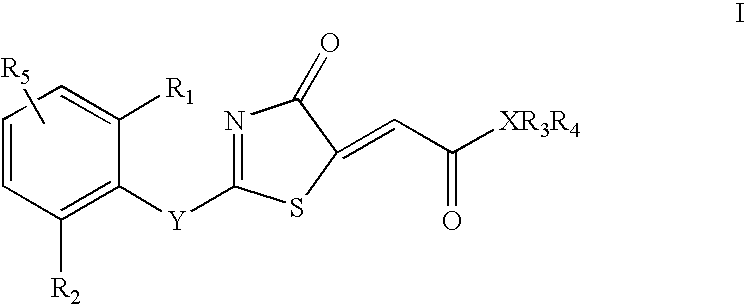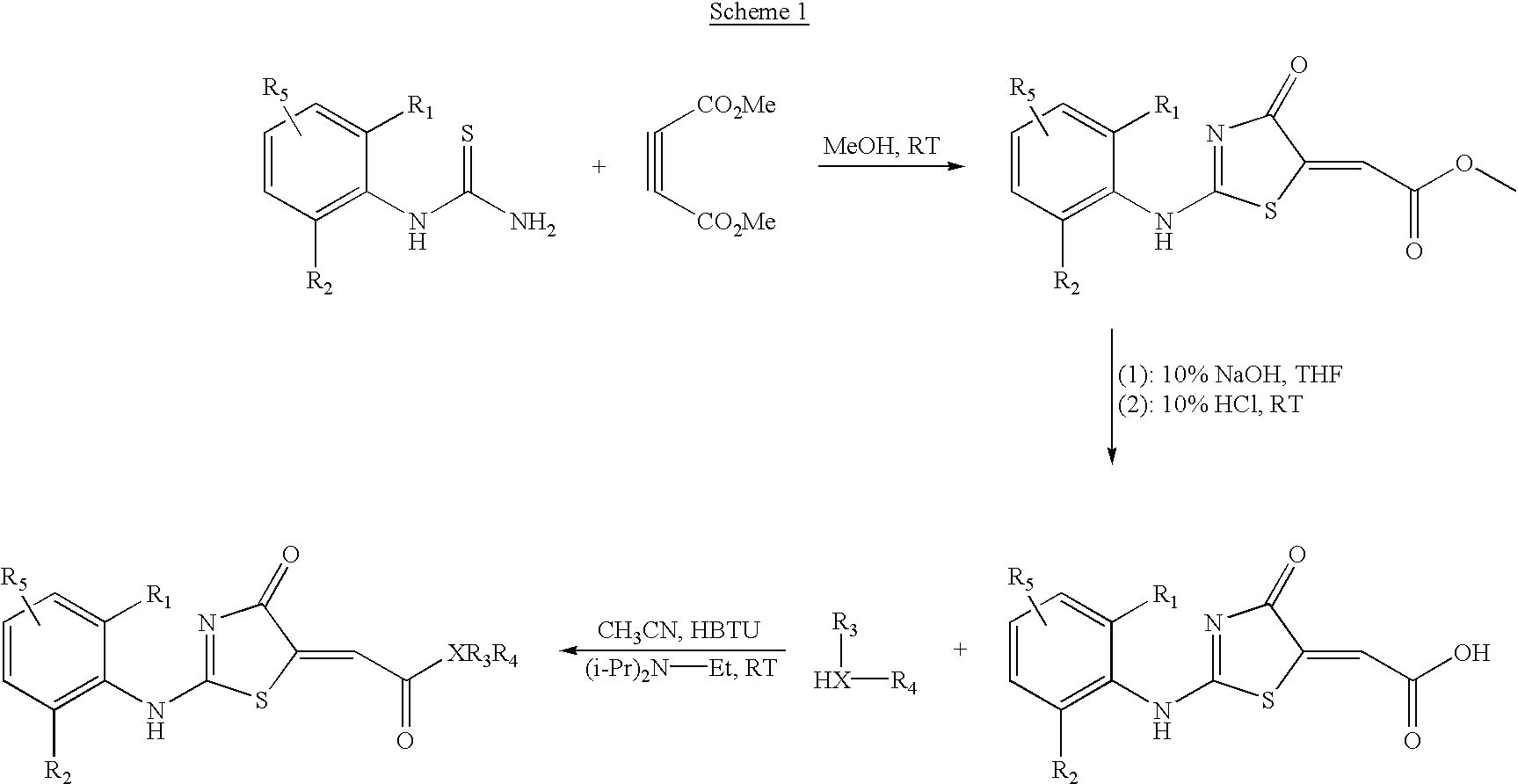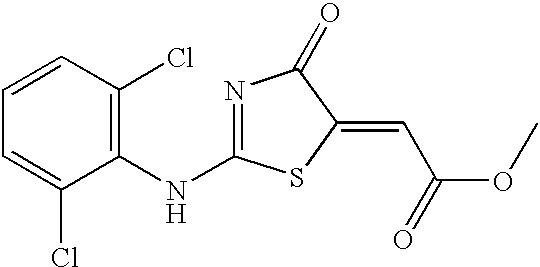Branched chain amino acid-dependent aminotransferase inhibitors and their use in the treatment of neurodegenerative diseases
a technology of aminotransferase inhibitors and amino acids, which is applied in the direction of biocide, drug composition, metabolic disorders, etc., can solve the problems of neurodegeneration and death, limited only by chemico-physical limitations
- Summary
- Abstract
- Description
- Claims
- Application Information
AI Technical Summary
Problems solved by technology
Method used
Image
Examples
example 2
ed in accordance with the methods of Example 1, except that diethyl acetylenedicarboxylate was used instead of the dimethyl acetylenedicarboxylate. The desired product was recrystallized from methanol to yield a yellow crystal (97% yield).
MS: 346.9 (M+1 for C.sub.13 H.sub.10 Cl.sub.2 N.sub.2 O.sub.3 S), TLC: SiO.sub.2, R.sub.f =0.80 (1:1 hexane / EtOAc). Mp: 185.0-185.8.degree. C., HPLC: C-18 Column (H.sub.2 O / CH.sub.3 CN=1:1 with 0.1% TFA), RT Time 13.1 minutes, Purity: 98.15%. Analysis (C.sub.13 H.sub.10 Cl.sub.2 N.sub.2 O.sub.3 S): (calc) C: 45.23, H: 2.92, N: 8.11, (found) C: 44.98, H: 2.75, N: 8.01; .sup.1 H NMR (400 MHz, CDCl.sub.3) .delta. 1.18 (t, 3H, J=7.5 Hz), 4.15 (q, 2H, J=6.6 Hz), 6.71 (s, 1H), 7.20 (t, 1H, J=7.3 Hz), 7.52 (d, 2H, J=8.1 Hz), 13.17 (s, 1H).
EXAMPLE 3
[2-(2,6-Dichloro-phenylamino)-4-oxo-4H-thiazol-5-ylidene]-acetic Acid Tert-butyl Ester
##STR5##
example 3
ed in accordance with the methods of Example 1, except that di-tert-butyl acetylenedicarboxylate was used instead of the dimethyl acetylenedicarboxylate. The desired product was recrystallized from methanol to yield a white crystal (95% yield).
MS: 374.9 (M+1 for C.sub.15 H.sub.14 Cl.sub.2 N.sub.2 O.sub.3 S), TLC: SiO.sub.2, R.sub.f =0.81 (1:1 hexane / EtOAc). Mp: >230.degree. C., HPLC: C-18 Column (H.sub.2 O / CH.sub.3 CN=1 / 1 with 0.1% TFA), RT Time 26.1 minutes, Purity: 98.93%. Analysis (C.sub.15 H.sub.14 Cl.sub.2 N.sub.2 O.sub.3 S): (calc) C: 48.27, H: 3.78, N: 7.51, (found) C: 47.68, H: 3.49, N: 7.39; .sup.1 H NMR (400 MHz, CDCl.sub.3) .delta. 1.38 (s, 9H), 6.59 (s, 1H), 7.18 (t, 1H, J=7.3 Hz), 7.52 (d, 2H, J=8.1 Hz), 13.15 (s, 1H).
EXAMPLE 4
[2-(2-Methyl-phenylamino)-4-oxo-4H-thiazol-5-ylidene]-acetic Acid Methyl Ester
##STR6##
example 4
ed in accordance with the methods of Example 1, except that 2-methylphenylthiourea was used instead of the 2,6-dichlorophenylthiourea. The desired product was recrystallized from ethyl acetate to yield a yellow crystal (92% yield).
MS: 277.0 (M+1 for C.sub.13 H.sub.12 N.sub.2 O.sub.3 S), TLC: SiO.sub.2, R.sub.f =0.69 (1:1 hexane / EtOAc). Mp: 200.7-201.2.degree. C., HPLC: C-18 Column (H.sub.2 O / CH.sub.3 CN=1 / 1 with 0.1% TFA), RT Time 5.61 minutes, Purity: 99.75%. Analysis (C.sub.13 H.sub.12 N.sub.2 O.sub.3 S): (calc) C: 56.51, H: 4.38, N: 10.14, (found) C: 56.58, H: 4.35 N: 9.96; .sup.1 H NMR (400 MHz, CDCl.sub.3) .delta. 2.09 (s, 3H), 3.68 (s, 3H), 6.69 (s, 1H), 7.18-7.30 (m, 4H), 12.65 (s, 1H).
PUM
| Property | Measurement | Unit |
|---|---|---|
| pH | aaaaa | aaaaa |
| pH | aaaaa | aaaaa |
| pH | aaaaa | aaaaa |
Abstract
Description
Claims
Application Information
 Login to View More
Login to View More - R&D
- Intellectual Property
- Life Sciences
- Materials
- Tech Scout
- Unparalleled Data Quality
- Higher Quality Content
- 60% Fewer Hallucinations
Browse by: Latest US Patents, China's latest patents, Technical Efficacy Thesaurus, Application Domain, Technology Topic, Popular Technical Reports.
© 2025 PatSnap. All rights reserved.Legal|Privacy policy|Modern Slavery Act Transparency Statement|Sitemap|About US| Contact US: help@patsnap.com



